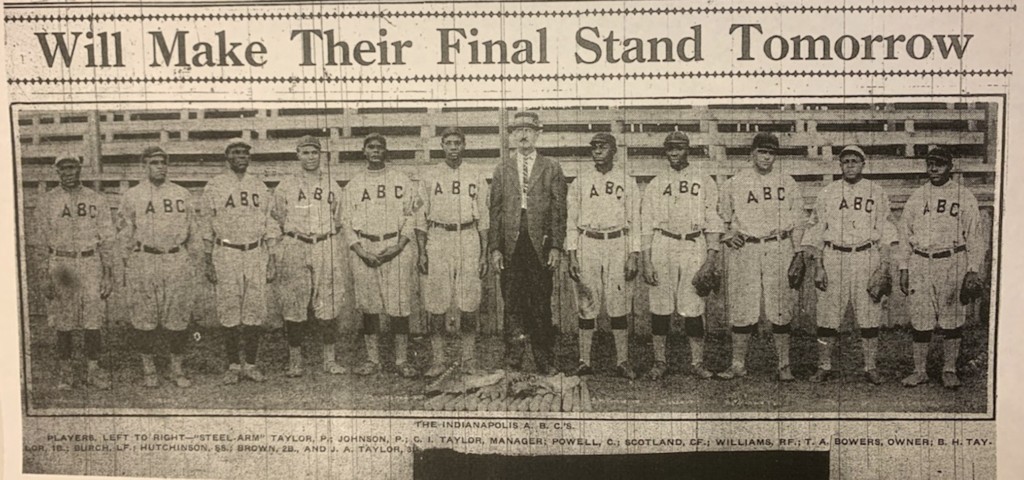On Dec. 16, Major League Baseball announced that it would add Negro League statistics to its official records. According to the league’s official website, “MLB is officially recognizing that the quality of the segregation-era circuits was comparable to its own product from that time period.” The statistics will come from the seven professional Negro Leagues that played between 1920 and 1948. This announcement adds approximately 3,400 players to the annals of Major League history.
When I first read the news, I immediately remembered an assignment I had when I was working the reference desk at the Tippecanoe County Public Library in the 2000s. Of course, researching articles on microfilm is pretty standard for anyone who works at a reference desk, but as someone who enjoys baseball statistics, I was excited to sit down at the reader and look up box scores of Negro League games that were played in and around the Lafayette area in the early 1900s. I don’t remember which specific box scores I researched, but I do remember wondering if the stats would ever be published anywhere.
Years later, I noticed my name was listed in a “thank you” section on the Negro League Data Sources page of the Baseball Reference website, along with the names of several other researchers from various Indiana public libraries. I had found the stats! It turns out that the researcher was Gary Ashwill, co-creator and lead researcher of the Seamheads Negro League Baseball Database, who also writes the blog Agate Type: Adventures in Baseball Archaeology. Ashwill is one of the leading researchers of Negro League statistics in the world. When the news of MLB adding the Negro League stats to their statistics broke, I wondered if any of the research conducted at the Indiana libraries would become official Major League statistics.
Fortunately, I was able to get in touch with Ashwill and he was kind enough to answer some questions and shed some light on the statistics researched at the Indiana libraries.
As a long-time researcher of baseball statistics with an emphasis on the Negro Leagues, what are your thoughts on Major League Baseball announcing that they will now include records from the seven Negro Leagues between 1920 and 1948 as part of their major league statistics?
It’s a day I did not ever contemplate happening, to be honest. I’m of two minds about it. On the one hand, it doesn’t change anything at all about what actually happened. Nearly all of the people who were directly affected by baseball’s color line have passed away, so it has the potential of seeming like an empty, even appropriative gesture. On the other hand, it carries tremendous symbolic importance, especially for baseball fans, and it could spread the story of the Negro Leagues much more widely than historians like me could really manage on our own.
Why is MLB including only stats from 1920-48 and not before?
Probably because before 1920 black professional teams were not organized into leagues, and it is still a fairly difficult lift to get some folks to consider teams that weren’t in leagues to be “major league” – even if they did employ some of the best baseball players in the country.
In the 2000s, you researched Negro League box scores at the New Castle-Henry County Library, the Muncie Public Library, the Indianapolis Public Library, the Tippecanoe County Public Library, the Brazil Public Library, the Morgan County Public Library, the Kokomo-Howard County Public Library and the Anderson Public Library. Why such a heavy emphasis on Indiana libraries?
Indiana was a very important arena for black professional baseball throughout the era of segregation. The places you mention were particularly important in the 1910s and 1920s because C. I. Taylor, the owner/manager of the Indianapolis ABCs, booked games against other strong black teams in many smaller cities and towns around Indiana. This was because the core of the Negro League fan base consisted of black fans in larger cities, but the amounts of disposable income were limited – so black teams commonly had to spend considerable amounts of time traveling around to seek out new fans and new markets. In smaller places, the arrival of polished professional ballplayers like the ABCs and their opponents was a big deal, and often received good coverage in the local papers.
MLB announced that they will be working with the Elias Sports Bureau to review and incorporate the statistics into Major League history. Will any of your research be included in the incorporated statistics?
Yes, we [Seamheads] are already speaking with Elias – it seems very likely we’ll be working together to figure it all out.
Finally, for anyone interested in sports-related statistical research, what advice would you give them?
Check as many sources as possible. This will help you spot mistakes in box scores or game stories and enable you to resolve anomalies. Also, not all material in a newspaper related to a game will appear in the article or box score that describes it. In particular, if the newspaper employed sports columnists, check their columns that day or even over the next few days – they will often have items or tidbits related to the game or the players you’re researching.
Also, when in doubt, ask a librarian! In the cases of many difficult-to-research smaller towns I wrote to librarians to help track down games I was looking for, and they were almost always able to help. It’s vital, of course, to do as much work as you can first to develop as precise an idea of what you need as possible, rather than asking someone to scroll through several months of microfilm for you. In one case, the newspaper microfilm of a box score was photographed out of focus, too blurry to read. I contacted a librarian in the city where the game was played, and they were able to check the bound volumes of the newspaper in question and send me a nice, sharp image of the box score.
I would like to thank Gary Ashwill, who took time out of his busy schedule of television appearances and meetings with the Elias Sports Bureau this week, for granting this interview.
This blog post was written by John Wekluk, communications director, Indiana State Library.



Thanks John for this blog post.
Very interesting!!